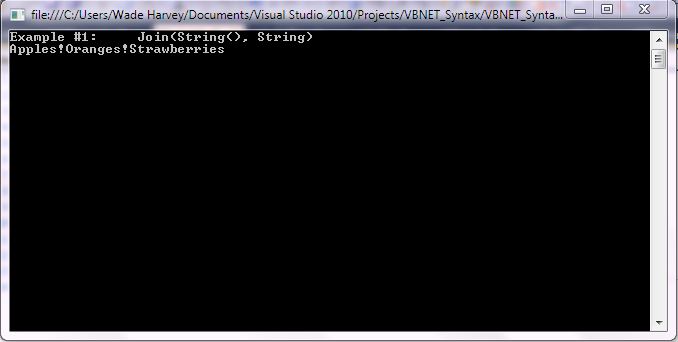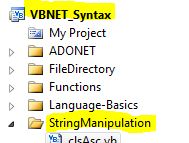VB.NET Join() – Code Sample Syntax Example
Posted by asp.net videos on Sunday, February 13, 2011 · Leave a Comment
Premium (Not Free) Video Tutorials
Free Video Tutorials & Free Tools
Premium (Not Free) Video Tutorials
Free Video Tutorials & Free Tools
VB.NET Join Example – Code Sample Syntax
Abstract: – Illustrates using VB.NET Join Code Example.
*** 2. Join Syntax ***
Purpose:
Returns a string created by joining a number of substrings contained in an array.
Syntax:
Join(SourceArray(), Delimiter)
| Parameters |
Description |
SourceArray |
One-dimensional array containing substrings to be joined.
|
| Delimiter |
Optional. Any string, used to separate
the substrings in the returned string. If omitted, the space
character (” “) is used. If Delimiter is a zero-length string
(“”) or Nothing, all items in the list are concatenated
with no delimiters.
|
| Result Data Type |
Description |
string |
Returns a string created by joining a number of
substrings contained in an array.
|
*** 3. Join – Quick Example ***
|
Dim arrayJoinExample() As String = {“Apples”, “Oranges”, “Strawberries”}
Console.WriteLine(Join(arrayJoinExample, “!”)) ‘Returns Apples!Oranges!Strawberries
|
*** 4. Join – Full Example ***
Join Example Output Screenshot

Step 1: Click Visual Basic to Cut-n-paste code into clsJoin.vb
Public Class clsJoin
Public Sub Main()
'****************************************************************************************
' Purpose: Returns a string created by joining a number of substrings contained in an array.
'
' Syntax: Join(SourceArray(), Delimiter)
'
' Parameter1: SourceArray - One-dimensional array containing substrings to be joined.
'
' Parameter2: Delimiter - Optional. Any string, used to separate
' the substrings in the returned string. If omitted, the space
' character (" ") is used. If Delimiter is a zero-length string
' ("") or Nothing, all items in the list are concatenated
' with no delimiters.
'
' Result: string - Returns a string created by joining a number of
' substrings contained in an array.
'
' Quick Example: Dim arrayJoinExample() As String = {"Apples", "Oranges", "Strawberries"}
' Console.WriteLine(Join(arrayJoinExample, "!")) 'Returns Apples!Oranges!Strawberries
'
'****************************************************************************************
Console.WriteLine("Example #1: Join(String(), String) ")
Dim arrayJoinExample() As String = {"Apples", "Oranges", "Strawberries"}
Console.WriteLine(Join(arrayJoinExample, "!")) 'Returns Apples!Oranges!Strawberries
'write blank line to make output easier to read
Console.WriteLine()
'Prevent console from closing before you press enter
Console.ReadLine()
End Sub
End Class |
Public Class clsJoin
Public Sub Main()
'****************************************************************************************
' Purpose: Returns a string created by joining a number of substrings contained in an array.
'
' Syntax: Join(SourceArray(), Delimiter)
'
' Parameter1: SourceArray - One-dimensional array containing substrings to be joined.
'
' Parameter2: Delimiter - Optional. Any string, used to separate
' the substrings in the returned string. If omitted, the space
' character (" ") is used. If Delimiter is a zero-length string
' ("") or Nothing, all items in the list are concatenated
' with no delimiters.
'
' Result: string - Returns a string created by joining a number of
' substrings contained in an array.
'
' Quick Example: Dim arrayJoinExample() As String = {"Apples", "Oranges", "Strawberries"}
' Console.WriteLine(Join(arrayJoinExample, "!")) 'Returns Apples!Oranges!Strawberries
'
'****************************************************************************************
Console.WriteLine("Example #1: Join(String(), String) ")
Dim arrayJoinExample() As String = {"Apples", "Oranges", "Strawberries"}
Console.WriteLine(Join(arrayJoinExample, "!")) 'Returns Apples!Oranges!Strawberries
'write blank line to make output easier to read
Console.WriteLine()
'Prevent console from closing before you press enter
Console.ReadLine()
End Sub
End Class Step 2: Click Visual Basic to Cut-n-paste code into Module1.vb
Module Module1
Sub Main()
Dim myclsJoin As New clsJoin
myclsJoin.Main()
End Sub
End Module |
Module Module1
Sub Main()
Dim myclsJoin As New clsJoin
myclsJoin.Main()
End Sub
End Module Prerequistes:
- Install Visual Basic (Express or Standard Edition)
- Install SQL Server Express
- Download Northwind and pubs Database
- Attach Northwind Database to Databases in Sql Express
- Attach pubs Database to Databases in Sql Express
Notes:
- Console Application is used to simplify things, but Windows Forms or Web Forms could also be used
- You can build a library of syntax examples by using same project over and over and just commenting out what you do not want to execute in Module1.vb
Instructions:

- Use Visual Basic 2010 Express or Standard Edition
- Create new project;
- Click File/New Project
- Select Console Application Template
- Select Visual Basic for Language
- name of project could be VBNET_Syntax.
- Add New folder named “StringManipulation”
- Right-click project name in solution explorer;
- add new folder;
- name of folder could be: StringManipulation
- Add Class Named clsJoin to StringManipulation folder
- Right-click StringManipulation folder;
- add new item;
- Select class
- Class name could be clsJoin
- Click on Visual Basic in code in step 1 above to copy code into clsJoin.vb
- Click on Visual Basic in code in step 2 above to copy code into Module1.vb
- Click green arrow or press F5 to run program
|
 Download Source Code for All VB Console Examples in One Project
Download Source Code for All VB Console Examples in One Project
